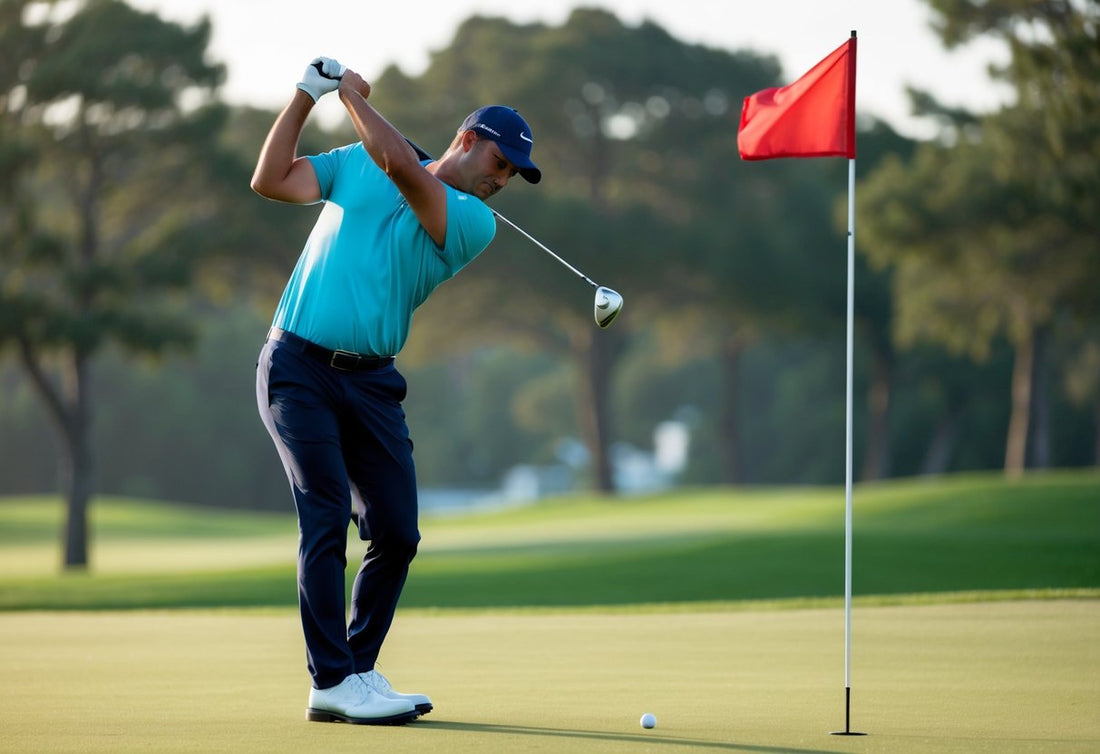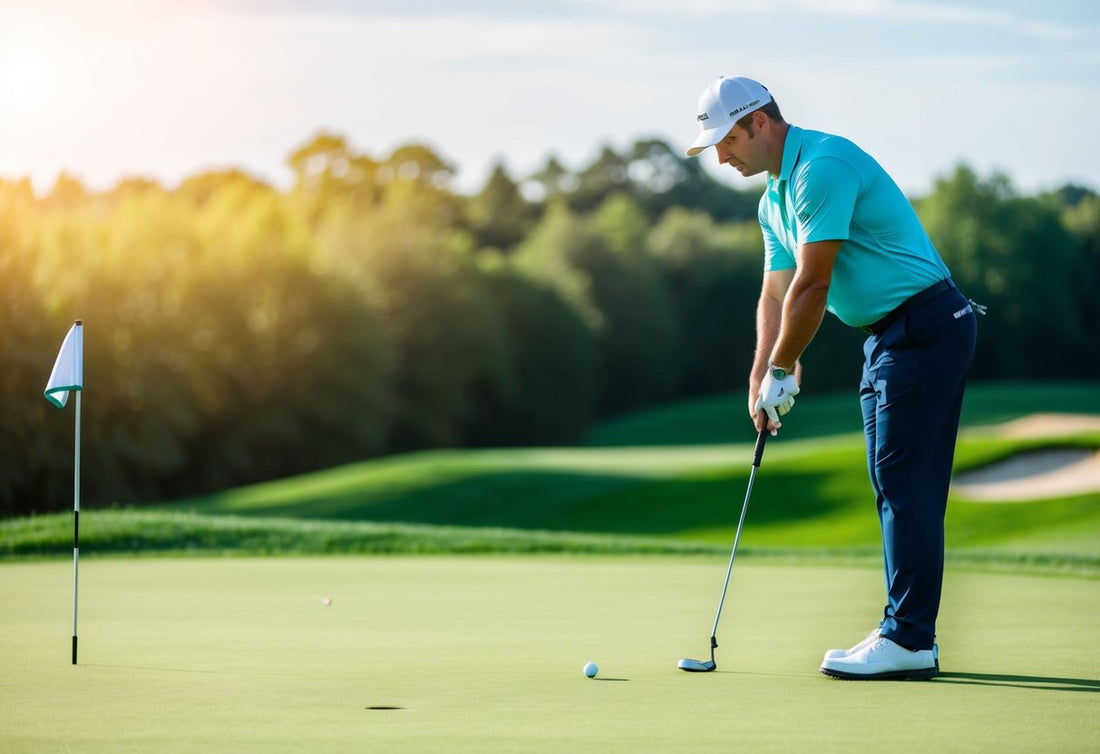Check out our golf rangefinders by Vovex to elevate your game!
Golf enthusiasts often encounter the term "GIR" when discussing player statistics and performance metrics. GIR stands for "Greens in Regulation," a crucial indicator of a golfer's accuracy and consistency on the course. This metric measures how often a player reaches the green in the expected number of strokes, based on the hole's par.
We've all experienced the thrill of landing our ball on the green with precision. GIR captures this skill, reflecting a golfer's ability to position themselves for successful putts. It's a key factor in lowering scores and improving overall play.
Understanding and improving your GIR percentage can significantly enhance your golf game. Let's explore this essential aspect of golf performance and discover strategies to boost your accuracy on the greens.
Key Takeaways
- GIR measures a golfer's accuracy in reaching greens within par-based expectations
- Improving GIR percentage can lead to lower scores and better overall performance
- Tracking and analyzing GIR helps golfers identify areas for improvement in their game
Understanding the Term 'GIR'
GIR is a crucial metric in golf that helps players and analysts evaluate performance. It measures a golfer's accuracy and consistency in reaching the green.
Definition of GIR
GIR stands for "Green in Regulation." We achieve a GIR when our ball reaches the putting surface in a specific number of strokes. For a par-3 hole, it's one stroke. On a par-4, it's two strokes. For a par-5, it's three strokes.
The key is to have at least one putt remaining for par. If we chip onto the green after reaching it in regulation, it still counts as a GIR.
Importance in Golf Statistics
GIR is a vital stat for assessing a golfer's skill level. A high GIR percentage often correlates with lower scores and better overall performance. Professional golfers typically aim for a GIR rate of 65-70% or higher.
We use GIR to identify areas for improvement in our game. A low GIR might indicate issues with approach shots or long-iron play. By tracking this stat, we can focus our practice on weak points.
GIR also helps us compare our performance to others. It's a standard measure used in professional tournaments and amateur competitions alike.
Calculating GIR in Golf
Greens in Regulation (GIR) is a crucial stat for golfers to track. It measures how consistently we reach the green in the proper number of strokes.
Step-by-Step Calculation
To calculate GIR, we first need to know the par for each hole. On a par 3, we must reach the green in 1 shot. For par 4s, it's 2 shots, and par 5s require 3 shots or fewer.
We count a GIR when our ball reaches the putting surface in these numbers. The ball must be on the green, not just near it.
After our round, we tally up our successful GIRs. We divide this number by the total holes played, then multiply by 100 for the percentage.
For example, hitting 12 greens in regulation on an 18-hole course gives us a GIR of 66.7%.
Common Misconceptions
Many golfers mistakenly think GIR only counts if they make par or better. This isn't true. We can three-putt for bogey and still get a GIR.
Another myth is that reaching the green in fewer strokes than required always counts. If we reach a par 5 green in 2 shots but land in a greenside bunker, it's not a GIR.
Some believe fringe shots count as GIR. They don't. The ball must be on the actual putting surface to qualify.
Lastly, we can't claim a GIR if we use a putter from off the green to reach it. The ball must land on the green from a full shot or chip.
Strategies to Improve GIR
Improving your Greens in Regulation (GIR) percentage can significantly lower your scores. Let's explore some effective techniques to boost your GIR performance on the course.
Pre-Shot Routines
A consistent pre-shot routine is crucial for better GIR stats. We recommend starting with a deep breath to calm your nerves. Next, visualize your ideal shot trajectory. Take a practice swing, focusing on the feel of a smooth, controlled motion.
Align your body and clubface carefully to your target. This step is often overlooked but can make a huge difference. A solid routine builds confidence and improves shot consistency.
Remember to maintain this routine for every approach shot, regardless of distance or situation. Consistency is key in golf, and a reliable pre-shot routine is the foundation of consistent play.
Club Selection
Proper club selection is vital for hitting more greens. We always assess the distance to the pin and consider factors like wind, elevation changes, and pin position. It's better to err on the side of caution - choosing a club that will comfortably reach the green is often smarter than pushing for maximum distance.
Consider using a range finder or GPS device for precise yardages. These tools can significantly improve your club selection accuracy.
Don't be afraid to use longer clubs for better control. Many amateurs underclub, leading to missed greens. When in doubt, choose the club that gives you the highest probability of reaching the green, even if it means landing short of the pin.
Approach Shot Accuracy
Accuracy in approach shots is crucial for improving GIR. We focus on hitting the center of the green rather than aiming directly at the flag. This strategy increases our margin for error and leads to more greens hit.
Practice different shot shapes to adapt to various course layouts. Being able to hit draws and fades on command gives us more options when approaching greens.
Work on distance control in your practice sessions. Hitting the green is great, but landing in the right area of the green is even better. Use alignment sticks on the practice range to improve your accuracy.
Lastly, don't forget about your short irons and wedges. Many GIR opportunities come from closer ranges, so honing these shots is essential for boosting your overall GIR percentage.
GIR's Impact on Scoring
Greens in Regulation (GIR) plays a crucial role in determining a golfer's score. It directly influences the number of putts needed and opportunities for birdies or pars.
Correlation Between GIR and Score
We've found a strong link between GIR percentage and scoring average. Golfers who hit more greens in regulation tend to post lower scores consistently. On the PGA Tour, the top GIR performers often lead in scoring average.
For example, in recent seasons, players with GIR percentages above 70% typically maintain scoring averages under 70 strokes per round. This correlation highlights the importance of accurate approach shots in competitive golf.
GIR also impacts a player's ability to avoid bogeys. By reaching the green in regulation, golfers give themselves a better chance to two-putt for par or better.
GIR Compared to Other Statistics
While GIR is crucial, it's not the only factor in scoring well. We've analyzed how it stacks up against other key stats:
- Driving Accuracy: Important, but less correlated with scoring than GIR
- Putting Average: Highly influential, often working in tandem with GIR
- Scrambling: Critical for saving par when GIR is missed
GIR stands out because it combines elements of both long game and approach play. A player with high GIR often excels in multiple areas of the game.
Interestingly, some golfers compensate for lower GIR with exceptional short game skills. However, consistently low scores are harder to achieve without a solid GIR percentage.
Tracking and Analysis
GIR tracking and analysis are crucial for improving golf performance. Modern technology and data-driven approaches have revolutionized how we measure and interpret this key metric.
Using Technology to Track GIR
We've seen a surge in golf tech that makes GIR tracking a breeze. GPS watches and smartphone apps now automatically record our shots and calculate GIR stats. Some advanced systems use sensors on clubs or balls to provide even more precise data.
These tools often sync with cloud platforms, giving us instant access to our GIR performance after each round. Many golfers find this real-time feedback invaluable for making immediate adjustments to their game.
Analyzing GIR Over Time
Examining GIR trends helps us spot patterns and areas for improvement. We can look at our GIR percentage across different courses, weather conditions, and seasons to identify strengths and weaknesses.
Many golfers create simple spreadsheets or use specialized golf analytics software to visualize their GIR data. These tools often allow us to compare our stats to handicap goals or tour pro averages.
By analyzing GIR alongside other metrics like fairways hit or putts per round, we gain a comprehensive view of our game. This holistic approach helps us develop targeted practice plans and strategies for lowering our scores.
Case Studies
Let's examine how GIR impacts professional and amateur golfers' performance through real-world examples.
Professional Players' GIR
We've observed remarkable GIR statistics among top professionals. Tiger Woods, in his prime, consistently achieved GIR percentages above 70%. During his record-breaking 2000 season, Woods hit an astounding 75.15% of greens in regulation.
Jordan Spieth's 2015 campaign showcased the power of high GIR. He led the PGA Tour with a 72.17% GIR, contributing to his two major victories that year.
On the LPGA Tour, Inbee Park's precision has been evident. In 2015, she topped the GIR charts at 79.10%, highlighting the importance of this stat in women's professional golf.
Amateur Player Improvements
We've seen significant progress in amateur golfers who focus on improving their GIR. A study of 100 mid-handicap players showed an average 5-stroke reduction over 18 holes when they increased their GIR by just 10%.
Local golf pro Sarah Thompson reported:
- 15-handicapper John improved from 4 to 7 GIR per round
- His scores dropped from mid-90s to mid-80s in 3 months
Weekend golfer Mike shared his experience: "Focusing on GIR helped me break 80 for the first time. I went from hitting 3-4 greens to 7-8 per round."
These examples demonstrate how GIR improvement can lead to lower scores for amateurs of all levels.
Practical Drills for GIR Improvement
Improving our greens in regulation (GIR) percentage requires focused practice and smart course management. Let's explore some effective drills and scenarios to sharpen our skills.
Target Practice on the Range
We can start by setting up target greens on the driving range. Place alignment sticks or flags at various distances to simulate green sizes. Begin with wedges and work our way up through the irons.
For each club, we'll aim to land 5 out of 10 shots within the target area. This drill hones our distance control and accuracy.
Next, we'll practice hitting to elevated targets. Stack range balls or use raised nets to mimic uphill approaches. This helps us gauge the right club selection for different elevations.
We can also work on shaping shots. Try hitting draws and fades to specific targets, improving our ability to navigate course obstacles.
Course Management Scenarios
On the actual course, we'll focus on strategic play to increase our GIR percentage. Let's start by playing a round using only irons off the tee. This forces us to think about positioning and approach angles.
We'll also practice the "worst ball" drill. Hit two tee shots and play from the worse position. This teaches us to recover from less-than-ideal situations.
Another useful exercise is the "GIR challenge." We'll aim to hit at least 12 greens in a round, regardless of score. This keeps our focus on approach shots and smart decision-making.
Lastly, we'll work on our lag putting from off the green. Improving our ability to get up-and-down saves strokes when we miss the green in regulation.
The Mental Game
The mental aspect of golf plays a crucial role in achieving greens in regulation. It requires focus, confidence, and emotional control to consistently hit accurate approach shots.
Psychological Aspect of GIR
We've found that a positive mindset is key to improving GIR performance. Visualizing successful shots before stepping up to the ball can boost confidence and execution. It's important to stay present and avoid dwelling on past mistakes or future outcomes.
Developing a pre-shot routine helps maintain focus and consistency. This might include taking a deep breath, visualizing the target, and committing to the shot. Mental rehearsal techniques can also enhance muscle memory and shot accuracy.
Key mental skills for GIR:
- Visualization
- Confidence building
- Focus and concentration
- Emotional regulation
Coping with Pressure
Pressure situations often arise when aiming for greens in regulation, especially during competitions. We've learned that embracing pressure rather than avoiding it can lead to better performance. Breathing exercises and positive self-talk are effective tools for managing stress.
It's crucial to maintain a consistent tempo and routine, regardless of the stakes. Focusing on the process rather than the outcome helps reduce anxiety and improves shot execution. Practice pressure situations during training to build resilience and familiarity with high-stress scenarios.
Pressure management techniques:
- Deep breathing
- Positive affirmations
- Maintaining routine
- Process-focused thinking
Frequently Asked Questions
GIR is a crucial golf metric that impacts scoring and strategy. Let's explore some common questions about this important statistic.
What does 'GIR' indicate in golf scoring?
GIR stands for "Green in Regulation." It measures how often a golfer reaches the green in the expected number of strokes. For par 3 holes, this means reaching the green with the tee shot. On par 4s, it's the second shot, and for par 5s, it's the third shot.
How do you calculate GIR accurately in golf?
We calculate GIR by tracking each hole during a round. If we reach the green within the expected number of strokes, we mark it as a GIR. At the end of the round, we divide the number of greens hit in regulation by the total number of holes played.
What is considered a good GIR percentage for amateur golfers?
For amateur golfers, a GIR percentage of 30-50% is often considered good. PGA Tour professionals typically hit 65-75% of greens in regulation. As we improve our skills, we aim to increase our GIR percentage gradually.
Can you explain the difference between FIR and GIR?
FIR (Fairway in Regulation) measures tee shots that land on the fairway. GIR focuses on reaching the green within the expected number of strokes. FIR applies only to tee shots on par 4 and par 5 holes, while GIR is relevant for all holes.
On a par 4, what does landing a GIR signify?
On a par 4, landing a GIR means we've reached the green in two strokes or fewer. This puts us in a good position to make par or better. It indicates we've executed our tee shot and approach shot effectively.
What strategies can help improve my GIR in golf?
To improve GIR, we can focus on consistent ball striking and course management. Practicing our iron play helps with accurate approach shots. We should also work on our tee shots to set up better angles to the green. Knowing our distances and club selection is crucial for hitting more greens in regulation.






